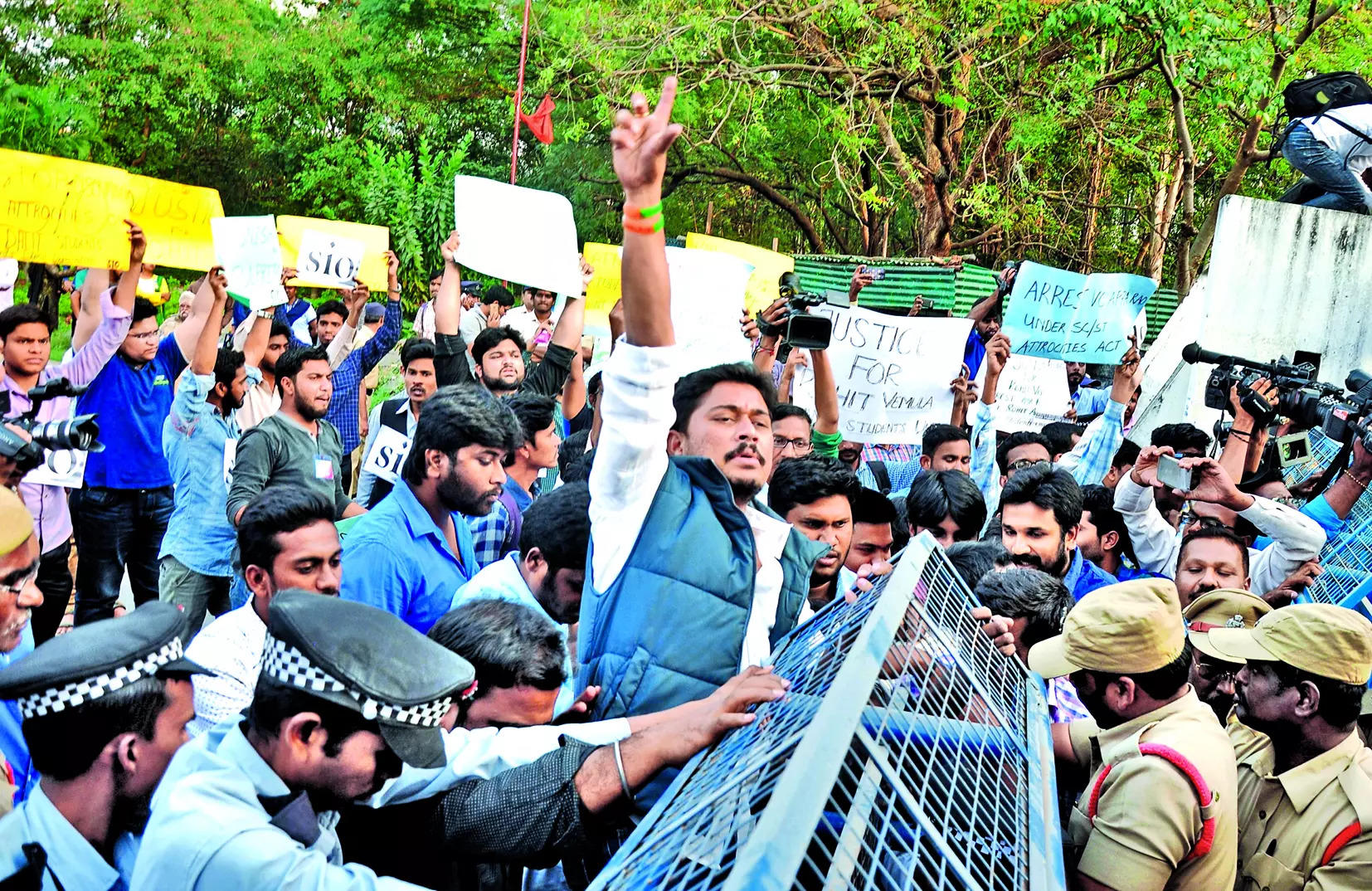Rebel DNA Stirs University of Hyderabad Protest Cauldron – Times of India
The screening was the most recent act of dissent on the campus, which has been intermittently on the boil since protests broke out after the suicide of Rohith Vemula in 2016. Both instances exposed fissures on the campus, triggering ripples across the state and country.
Agitation is not new to students, who have been politically active since the Eighties. UoH, which was established in 1974, has witnessed several Left-Dalit movements.
“The ‘movement culture’ began at UoH in 1985,” said K Laxminarayana, a professor at School of Economics, who has been working at the varsity for more than three decades. He said, the Karamchedu killings of Dalits by upper-caste landlords sparked outrage and triggered a movement, ‘Dalits for Dalits’, which got massive support from UoH students.
“Since then, we have witnessed many student-led movements against atrocities, discrimination, infrastructural problems, among other issues. A suicide by a Dalit woman student in the early 90s led to a major movement at UoH. In the late nineties, suicide by a boy from Tamil Nadu and two students from Telangana also brought Dalit issues to the forefront,” he added, saying most movements at UoH are led by Left and Dalit students, unlike in universities like Jawaharlal Nehru University (JNU), where they are dominated by Leftists.
By the mid-90s, the varsity had begun seeing more political activism, said students and faculty members. “When I was a Master’s student, the campus was small. But when I joined back as a faculty member seven years later, it was a completely different university. There was political activism and polarisation. The caste and gender consciousness became more visible,” said Vinod Pavarala, who did his PG at UoH between 1985 and 1987 and has been faculty member since 1995.
He said post-Mandalisation of politics (rebellion against upper-caste dominance), the composition of students at the varsity has changed, which brought in positive changes. “The academic productivity started increasing during this period and parallel activism also grew,” added Pavarala. In the early 90s, the rape of a girl student ushered feminist consciousness in the university with faculty and students attending trial at the court to support the victim.
However, till mid-2000, student wings of political parties did not function under their own banners. For instance, Akhil Bharatiya Vidyarthi Parishad (ABVP) was operating under the name ‘Discovery’ and the coalition of SFI was known as University Discussion Forum (UDF).
During the tenure of JNU alumnus Seyed E Hasnain, who was UoH vice-chancellor between 2005 and 2011, party-based student politics were encouraged on the campus. And with the influx of younger batches of integrated undergraduate students in the same period, a clear political divide on campus emerged. In the following decade, ABVP gained prominence, even winning a few student union elections, said a senior campus faculty member.
During this period, the suicide of PhD student Senthil Kumar in 2008, led to Pavarala Committee pointing to discrimination against students from marginalised sections as a key reason for the student taking such a drastic step. The committee suggested measures such as the double-blind system for PhD admissions and immediate assignment of guides to research scholars.
Subsequently, in 2013, the Krishna Committee’s report, which looked into the suicide of a PhD student Madari Venkatesh, also highlighted instances of insensitivity towards students from marginalised sections of society.
Agitations triggered by Rohith’s Vemula’s suicide, which students labelled as ‘institutional murder’, led students to demand passage of the Rohith Act. “We believe we managed to raise Dalit consciousness in BJP. After the Rohith movement, suicides by Dalit students have dipped. Recently, when a Dalit student committed suicide at IIT Bombay, the Rohith Act again became a point of discussion,” said Munna Sannaki, who was at the forefront of the Rohith movement and was also president of Ambedkar Students Association (ASA).
“Things began changing for the better after we started contesting in student elections for executive roles. The campus became more secular, more inclusive, and more democratic and since 2007, we have won five times,” he added. It’s high time various committees and redressal mechanisms are strengthened to create a safe environment for students at UoH, said Munna.
Currently, UoH has a vibrant student politics scene with various student organizations representing different ideologies and interests and politics is centred around issues like social justice, caste discrimination, campus infrastructure, hostel facilities and academic policies.
Agitations at University of Hyderabad
1985 Protest against Karamchedu killings
2008 Protest demanding justice for Senthil Kumar, who committed suicide
2011 Protests against fee hike
2014 Protests against UPA government
2015 ‘Occupy UoH’
2016 Rohith Vemula movement
2016 ‘Justice for Najeeb’ movement
2019 Fee hike protests
2019 Anti-Citizenship Amendment Act protests
2023 Screening of banned BBC documentary on PM Modi
The ‘movement culture’ began at UoH in 1985. Since then, we have witnessed many student-led movements against atrocities, discrimination, infrastructural problems, among other issues. –
K Laxminarayana
|professor, school of economics, uoh
Things began changing for the better after we started contesting in student elections for executive roles. The campus became more secular, more inclusive, and more democratic and since 2007, we have won five times
—Munna Sannaki
| student, ex-president of asa.
For all the latest Education News Click Here
For the latest news and updates, follow us on Google News.


